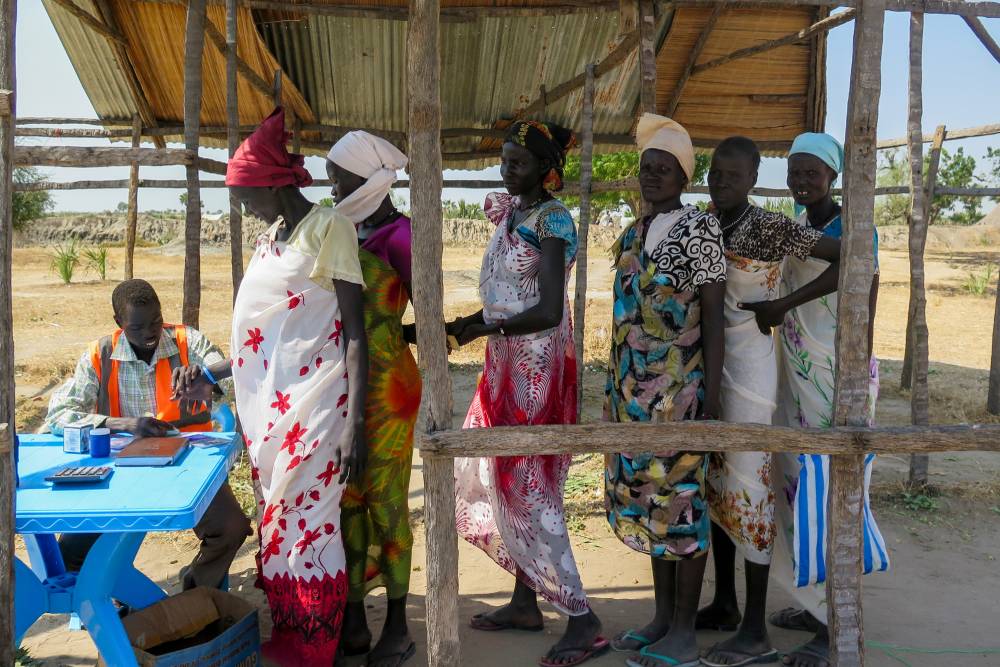Next week, when States meet in San José, Costa Rica, at the Second International Conference of the Political Declaration on Strengthening the Protection of Civilians from the Humanitarian Consequences Arising from the Use of Explosive Weapons in Populated Areas (EWIPA), they do so against a sobering backdrop. In conflicts from Gaza to Sudan, Myanmar to Ukraine, civilians continue to bear the brunt of explosive violence. In 2024, the number of reported civilian casualties from explosive violence surged to nearly 60,000 – a 69% increase from the previous year.
The impacts of conflict are felt differently by individuals. Factors such as sex, age and gender shape how civilians experience and recover from explosive violence. The EWIPA political declaration recognizes these realities. It explicitly acknowledges the severe direct and indirect harm caused to civilians — including women, men and children — and commits States to provide assistance that is holistic, inclusive and sensitive to gender, age and disability.
As the San José conference focuses on turning these words into concrete action, one lesson stands out from decades of humanitarian disarmament: Age- and gender-sensitive victim assistance is not optional. It is essential. Understanding why it matters is fundamental to moving from commitments to long-lasting change for civilians and communities affected by explosive weapons.
1. Tailored victim assistance delivers real results
Programmes tailored to survivors’ specific needs lead to higher participation by those most affected, faster recovery and better long-term reintegration.
Gender responsive initiatives such as mobile clinics staffed by gender-balanced teams have shown to increase uptake of care in contexts where women and girls often face cultural or logistical barriers to accessing health services, while cash and voucher programmes that take gender into consideration in their design have enabled women survivors to start small businesses and regain livelihoods. By doing so they contribute to family and community resilience, and prevent the adoption of negative survival strategies.
Age-appropriate assistance that anticipates changing bodies and needs is vital to children injured by explosive weapons (who may need up to 25 prosthetic replacements over a lifetime) – it helps to ensure continuity of care, access to education and greater social inclusion. The establishment of peer-to-peer support networks and integration of mental health support with other programmes can reach men who may be more reluctant to seek mental health support.
Acknowledging the different and diverse needs of affected civilians by integrating age and gender considerations throughout the entire programme cycle, means victims and survivors have a greater chance of benefitting equally. Tailored interventions may cost more upfront, but they save resources in the long run. They reduce dropout rates, minimize duplication, and promote self-sufficiency. Designing for difference is simply smarter humanitarian investment.
2. Recovery isn’t one-size-fits-all
The consequences of the use of explosive weapons are anything but equal. Gender and age shape both who is harmed and how recovery unfolds.
The sex, age and gendered dimensions of war are well documented. Explosive weapons harm individuals differently — because of both biological differences, and because of distinct gendered social roles that influence exposure to harm. For example, pregnant women face a higher risk of pregnancy-related complications, including miscarriages. Children are more likely to die from blast injuries than adults, their smaller bodies making blast injuries more severe and rehabilitation more complex.
Men and boys are often the most frequent direct casualties of explosive violence due to the work they do and their daily routines in conflict; however in some contexts, such as Gaza and Syria – where explosive weapons have been used to target densely populated neighbourhoods – women, children and older people are often among the most directly affected, because they are more likely to be at home.
Beyond physical injuries, the use of explosive weapons causes psychological harm that can impact families for generations. While all civilians are likely to experience some form of mental health trauma, children’s exposure to violence and loss of loved ones and homes is more likely to cause acute and lasting psychological consequences than in adults. Older people also face distinct and layered vulnerabilities — mobility challenges, chronic illness, loss of caregivers, and isolation – that cause mental health impacts.
Access to care is also heavily influenced by cultural and economic barriers. Women and girls with visible injuries are more likely to experience stigma and exclusion, which may prevent them from seeking assistance. Similarly men and boys are also more likely to experience stigma when seeking mental health support due to cultural and gender norms. Older people can also experience discrimination due to their age; many can also find themselves cut off from medical support or caring for grandchildren with no access to assistance.
Treating survivors as a uniform group leads to inefficiency and waste — prosthetics that no longer fit, unreachable health services, and financial constraints that deepen inequalities and exclusion. By contrast, assistance designed with gender and age considerations in mind achieves measurable improvements in recovery, participation and long-term wellbeing. An approach that recognises difference delivers better outcomes for everyone.
3. Inclusive recovery rebuilds trust
Victim assistance does more than heal bodies — it helps rebuild societies. When survivors are meaningfully included in recovery planning and community life, they help rebuild trust and resilience from the ground up. Inclusion turns assistance into a shared social process – one that restores dignity and belonging.
When women, youth, older persons, and persons with disabilities participate in decision-making, communities become more representative and responsive. Conversely, exclusion creates new divisions: people left without livelihoods, children whose rehabilitation ends halfway, older survivors cut off from care. Such gaps fracture the very social foundations that recovery seeks to restore.
Inclusive victim assistance recognizes survivors not only as beneficiaries but as agents of change. By visibly addressing disparities in service provision – for example, by working to ensure women are included in livelihood projects –, it reduces perceptions of neglect and helps to restore trust in local institutions. Rebuilding is strongest when everyone belongs, and when every survivor’s voice helps shape the future.
4. Inclusion delivers on disarmament, development and peace
By delivering on the political declaration’s commitments to inclusive victim assistance, States can contribute to peacebuilding, sustainable development, and gender equality. Victim assistance that includes women and girl victims and survivors in all their diversity can complement and amplify efforts under the Women, Peace and Security Agenda.
Inclusive victim assistance that aims to ensure no-one is left behind and activities to promote the 2030 Agenda on Sustainable Development Agenda are often mutually reinforcing. And local victim assistance interventions can be a powerful tool in supporting community-based peacebuilding and security, addressing underlying drivers of fragility while strengthening social cohesion, trust and resilience.
Peer-to-peer support networks, for example, create a space where people can jointly share information on recovery and engage in activities that rebuild community bonds.
5. States have already committed to it
The political declaration on EWIPA commits States to providing “holistic, integrated, gender-sensitive and non-discriminatory assistance” to victims. This builds on a growing body of disarmament practice including from the Anti-Personnel Mine Ban Convention to the Convention on Cluster Munitions.
But implementation gaps remain wide. Age- and gender-disaggregated data are scarce; funding for tailored services is inconsistent; and coordination between government, humanitarian and local actors often falls short. Some countries, however, are showing what progress looks like:
- Colombia, for example, has integrated age, gender and disability dimensions into its national framework for victims of conflict, ensuring that survivor support spans psychosocial, educational and economic domains. The national mine action authority is also in the process of formalising peer-to-peer support networks as ‘Victim Associations’ to bridge the gap between national policies and local realities, and to promote the socioeconomic inclusion of victims and survivors.
- Cambodia’s mine action authority established a gender mainstreaming team, improving representation and outcomes for women survivors and community deminers alike, and incorporated diversity objectives into its 2019-2025 strategy. It has also adopted a Gender Mainstreaming in Mine Action Plan that includes collection and use of disaggregated data in planning and prioritization of mine action activities including victim assistance.
These examples demonstrate that inclusive policy design is achievable — and it works. The San José conference offers an opportunity for States to share experiences, renew commitments, and translate these commitments into action.
From words to action
Age- and gender-sensitive victim assistance works better, costs less over time, and delivers more equitable and enduring recovery. States gathering in San José should consider the following recommendations as critical steps towards making victim assistance work for civilians in their diversity:
- Share good practices and foster knowledge exchange and dialogues in order to inform more effective, age- and gender-sensitive programming under the political declaration.
- Fund victim assistance programmes that integrate inclusion throughout the design, implementation and evaluation phases.
- Discuss and agree concrete steps towards improving the collection of disaggregated data on the victims of explosive weapons and use it to inform tailored and effective victim assistance.
- Prioritize and fund interventions such as peer-to-peer support networks and cash assistance programmes that have proven to be efficient, sustainable and capable of reaching those at greatest risk of exclusion.
- Improve knowledge among diplomats, funders, government officials and implementing partners on what age- and gender-sensitive victim assistance entails.
The global outlook is deeply challenging. Cuts have left critical national aid budgets in tatters, humanitarian needs are rising and conflicts protracted, progress made in gender and diversity is being actively dismantled, and trust in multilateralism is under severe strain. Yet this is precisely why the commitments under the political declaration on EWIPA matter.
They remind us that protecting civilians is not an abstract principle — it is a daily test of our collective humanity and commitment to protect those most vulnerable.

